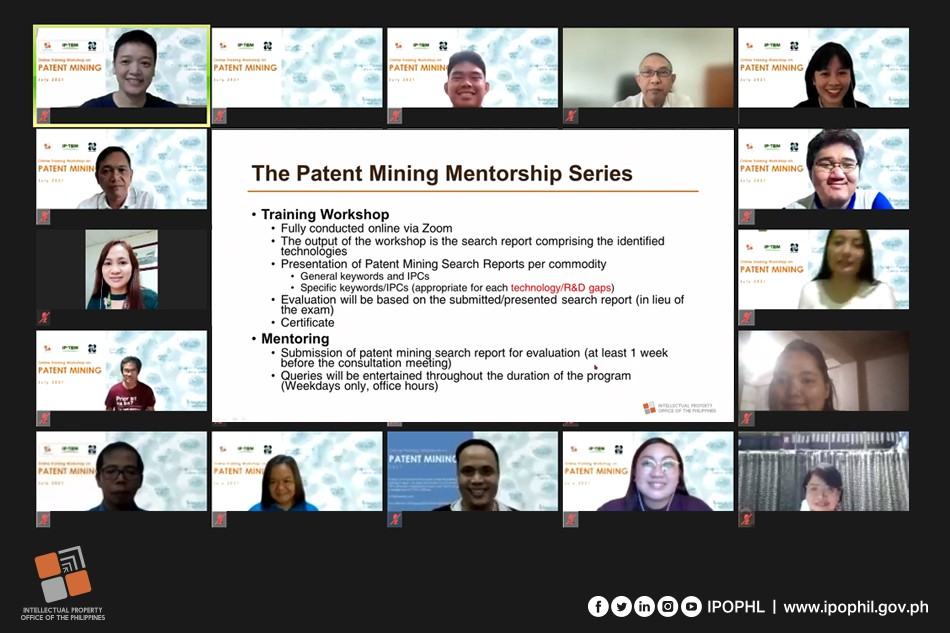The Intellectual Property Office of the Philippines (IPOPHL) is undertaking a new collaboration with the Department of Science and Technology (DOST) to further the country’s research and technology advancements in the agriculture and natural resources sector by encouraging the use of patent information.
Through the collaboration ongoing this month, IPOPHL’s Intellectual Property Business Services and Development Division (IPBSDD) is providing a series of training on patent search and patent mining to support 17 state universities and colleges (SUCs) and research and development institutions (RDIs) in conducting studies on 17 farm and fishery commodities identified in the priority R&D programs of the DOST’s Philippine Council for Agriculture, Aquatic, and Natural Resources Research and Development (PCAARRD).
Below are the SUCs and RDIs and their chosen commodities for research, which were selected based on their abundance in their respective regions and on their specializations:
- Coffee – Cavite State University (CvSU)
- Rice – Bohol Island State University (BISU)
- Mango – Bataan Peninsula State University (BPSU)
- Swine – Central Mindanao University (CMU)
- Cacao – Caraga State University (CSU)
- Bamboo – DOST – Forest Products Research and Development Institute (DOST-FPRDI)
- Banana – Ifugao State University (IfSU)
- Goat – Isabela State University (ISU)
- Aqua feeds – Laguna State Polytechnic University (LSPU)
- Citrus – Nueva Vizcaya State University (NVSU)
- Dairy cattle – Philippine Carabao Center (PCC)
- Milkfish – Pampanga State Agricultural University (PSAU)
- Crabs (mangrove and blue swimming crabs) – Samar State University (SSU)
- Shrimp – University of the Philippines Visayas (UPV)
- Rubber – University of Southern Mindanao (USM)
- Native chicken – Western Mindanao State University (WMSU)
- Seaweeds/Sea cucumber – Western Philippines University (WPU)
“The use of patent information to gain insight on the advancement of technologies concerning particular fields of interest has been part of IPOPHL’s mission of making IP useful for the masses in concrete and tangible aspects made possible through technology and knowledge transfer. This patent mining project is one example of making IP work in the real world,” IPOPHL Director General Rowel S. Barba.
The IPBSDD’s collaboration with the PCAARRD is ongoing and is the second of its kind that promotes the use of patent information in R&D planning. The first joint project, which ran from 2017 to 2019, yielded 12 PLRs on abaca, bamboo, banana, crab, goat, livestock feed resources, mango, milkfish, natural rubber, rice, shrimp, and swine.
The objective of the previous collaboration was to provide a comprehensive analysis of available worldwide patent data, such as patent grants, published pending applications and utility models and other information on technologies related to commodities, which the PCAARRD and its stakeholders have identified as strategic in making the Philippine agriculture sector more competitive.
“The IPOPHL’s collaboration with PCAARRD is in the hopes of bringing awareness on patent information as an important resource for developing research projects or funding strategies in various technological clusters even in agriculture. Understanding the patent landscape also helps in identifying collaborators and partners, exploring jumping-off points for R&D activities, supporting a data-informed approach in decision-making and reducing the likelihood of wasting efforts and resources on crowded technological space,” Barba added.
IPOPHL began the patent mining mentorship series last July 5 and will continue until all SUCs and RDIs complete their research work on concerned areas.














